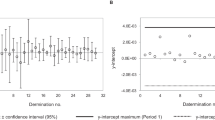Abstract
A reliable and accurate analytical method was developed and validated for the quantitative determination of polyphosphates (diphosphate, triphosphate, trimetaphosphate and tetrapolyphosphate) in products of animal origin (meat, dairy and fish products) by ion chromatography with suppressed conductivity detection. The chromatographic separations were accomplished by using an anion-exchange column eluted with a sodium hydroxide gradient. The method validation, performed according to Regulation 882/2004/EC and Decision 657/2002/EC, provided results conform with the European Directives with respect to linearity (R > 0.996), specificity, precision (CV ≤ 4.5 %), recovery (ranging from 87.2 to 101.1 %), detection and quantification limits and ruggedness. The method reliability was confirmed evaluating the method measurement uncertainty, lower than 7.5 % and by proficiency test results. Finally, the method ability to discriminate samples treated from those not-treated with polyphosphates was verified by analyzing commercial samples containing polyphosphates (cooked ham, wurstel, corned beef, processed cheese and surimi) or treated in-house with polyphosphates (pangasius fillets, shrimps and cuttlefishes).






Similar content being viewed by others
References
Jolley PD, Purslow PP (1988) Reformed meat products: fundamental concepts and new developments. In: Mitchell JR, Blanshard JMV (eds) Food structure: its creation and evaluation. Butterworths, Surrey
Kulaev IS, Vagabov VM, Kulakovslaya YV (2004) The biochemistry of inorganic polyphosphates, 2nd edn. Wiley, The Atrium
Bendall JR (1954) The swelling effect of polyphosphates in lean meat. J Sci Food Agric 5:468–475
Trout GR, Schmidt GR (1983) Effect of phosphate type and concentration, salt level and method of preparation on binding in restructured beef rolls. J Food Sci 49:687–694
Jolley PD, Savage AWJ (1985) Protein solubilisation and adhesion in reformed meats. Paper presented at Symposium, Fleischforschung aktuell, Kulmbach 2–8
Grabowska J, Hamm R (1979) Protein solubility and water binding under the conditions obtaining in brühwurst mixtures. Fleischwirtschaft 59:1166–1172
Turner RH, Jones PN, Macfarlane JJ (1979) Binding of meat pieces: an investigation of the use of myosin-containing extracts from pre- and post-rigor bovine muscle as binding agents. J Food Sci 44:1443–1446
Kotter L, Fisher A (1975) The influence of phosphates or polyphosphates on the stability of foams and emulsions in meat technology. Die Fleischwirtschaft 55:365–368
Offer G, Knight P (1988) In: Lawrie R (ed) The structural basis of water-holding in meat, part 1: general principles and water uptake in meat processing. Elsevier, Amsterdam
European Commission (2010) Note to the members of the standing committee on the food chain and animal health. Subject: The use of polyphosphates in the production of salted fish. SANCO/E3/WD/km D. Brussels
Commission European (1995) Directive (EC) No. 95/2, 20 Feb 1995. Off J Eur Union L061:1–40
Norma MS, Steinhardt Bour J, Barbara MS, Soullier A, Zemel MB (1984) Effect of level and form of phosphorus and level of calcium intake on zinc, iron and copper bioavailability in man. Nutr Res 4(3):371–379
Carey MC (1992) Pathogenesis of gallstones. Recenti Prog Med 83(7–8):379–391
Robertson K (2000) The study of polyphosphate hydrolysis using 31P NMR, Phase II. In: Proceedings of the Tennessee Academy of Science 2000
International Organization for Standardization (1980) ISO 5553:1980 Meat and meat products—detection of polyphosphates. Switzerland, Geneva
Sekiguchi Y, Matsunaga A, Yamamoto A, Inoue Y (2000) Analysis of condensed phosphates in food products by ion chromatography with an on-line hydroxide eluent generator. J Chromatogr A 881:639–644
Iammarino M, Di Taranto A, Palermo C, Centonze D (2009) Polyphosphates in products of animal origin: validation of an analytical method based on ion chromatography with electrochemical conductivity detection. XXIII Congresso Nazionale della Società Chimica Italiana, Sorrento 5–10 luglio 2009, Book of abstract 97
Shamsi SA, Danielson ND (1995) Ribonucleotide electrolytes for capillary electrophoresis of polyphosphates and polyphosphonates with indirect photometric detection. Anal Chem 67:1845–1852
Stover FS (1997) Capillary electrophoresis of longer-chain polyphosphates. J Chromatogr A 769:349–351
Lee A, Whitesides GM (2010) Analysis of inorganic polyphosphates by capillary gel electrophoresis. Anal Chem 82:6838–6846
Shamsi SA, Danielson ND (1993) Ion chromatography of polyphosphates and polycarboxylates using a naphthalenetrisulfonate eluent with indirect photometric and conductivity detection. J Chromatogr A 653:153–160
Svoboda L, Schmidt U (1997) Single-column ion chromatography of linear polyphosphates. J Chromatogr A 767:107–113
Baluyot ES, Hartford CG (1996) Comparison of polyphosphate analysis by ion chromatography and by modified end-group titration. J Chromatogr A 739:217–222
Nguyen MV, Jonsson JO, Thorkelsson G, Arason S, Gudmundsdottir A, Thorarinsdottir KA (2012) Quantitative and qualitative changes in added phosphates in cod (Gadus morthua) during salting, storage and rehydration. LWT. Food Sci Technol 47(1):126–132
Cui E, Cai F, Xu Q (2000) Determination of tripolyphosphate in frozen cod and scallop adductor by ion chromatography. J Chromatogr A 884:89–92
Kaufmann A, Maden K, Leisser W, Matera M, Guden T (2005) Analysis of polyphosphates in fish and shrimps tissues by two different ion chromatography methods: implications on false-negative and -positive findings. Food Addit Contam 22(11):1073–1082
Dionex Corporation (2011) Dionex Application Note 71. http://www.dionex.com/en-us/webdocs/4166-AN71_V18.pdf. Accessed 07 Nov 2011
Commission European (2002) Decision (EC) No. 657/2002, 12 August 2002. Off J Eur Union L221:8–36
Commission European (2004) Regulation (EC) No. 882/2004, 29 April 2004. Off J Eur Union L165:1–141
Youden WJ, Steiner EH (1975) Statistical manual of the AOAC. Association of the Official Analytical Chemists, Washington
Miller EJC, Miller JN (1993) Statistics for analytical chemistry, 3rd edn. Ellis Horwood PTR Prentice Hall, New York
Hund E, Massart DL, Smeyers-Verbeke J (2001) Operational definitions of uncertainty. Trends Analyt Chem 20(8):394–406
Nordic Committee on Food Analysis (NMKL) (2003) Estimation and expression of measurement uncertainty in chemical analysis, 2nd edn. NMKL Secretariat, Helsinki
Acknowledgments
Ministero della Salute (Rome, Italy) is thanked for providing financial support.
Author information
Authors and Affiliations
Corresponding author
Rights and permissions
About this article
Cite this article
Iammarino, M., Di Taranto, A. Determination of polyphosphates in products of animal origin: application of a validated ion chromatography method for commercial samples analyses. Eur Food Res Technol 235, 409–417 (2012). https://doi.org/10.1007/s00217-012-1766-z
Received:
Revised:
Accepted:
Published:
Issue Date:
DOI: https://doi.org/10.1007/s00217-012-1766-z




